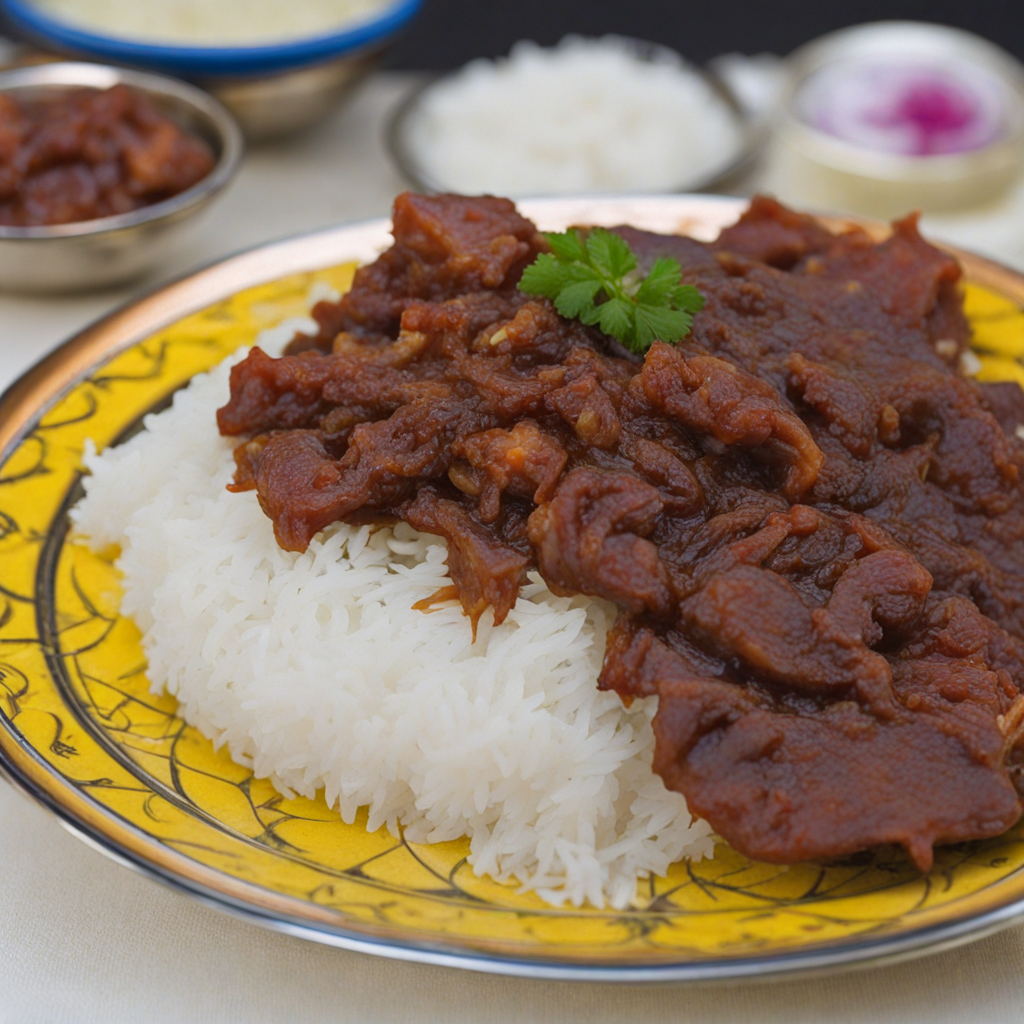Yemeni Bint Al Sahn
Yemeni Bint Al Sahn is a delightful and unique dish that hails from the culinary traditions of Djibouti, showcasing a rich tapestry of flavors and textures. This dish is a luscious layered pastry that features thin sheets of dough, similar to a delicate phyllo, which are generously brushed with ghee or clarified butter. Each layer is interspersed with a sweet mixture of honey and spices, typically including cardamom and cinnamon, creating a heavenly aroma that fills the air as it bakes. The result is a golden, flaky pastry that is both crispy and tender, making it an irresistible treat for anyone who enjoys sweet pastries. As you take your first bite of Bint Al Sahn, you are greeted with a symphony of sweetness that harmonizes beautifully with the warm spices. The honey not only sweetens the dish but also adds a sticky, luscious quality that binds the layers together. The subtle crunch of the outer layers gives way to a soft and moist interior, drawing you deeper into the experience with each mouthful. Often served warm, this dish is perfect for sharing, making it a popular choice for gatherings and special occasions in Djibouti. Bint Al Sahn is typically enjoyed with a cup of strong, spiced tea or coffee, enhancing its rich flavors and providing a perfect balance to the sweetness. Traditionally, it might also be garnished with nuts or a dusting of powdered sugar, adding an extra layer of texture and flavor to the dish. Whether you’re indulging in it as a dessert or a sweet snack, Yemeni Bint Al Sahn offers an enchanting glimpse into the culinary heritage of Djibouti, promising a memorable experience for those willing to explore its exquisite taste.
How It Became This Dish
The Culinary Journey of 'بنت الصحن' (Bint al-Sahn) from Djibouti Origin and Historical Context 'بنت الصحن' (Bint al-Sahn), translated as "Daughter of the Plate," is a traditional dish that is emblematic of the culinary heritage of the Horn of Africa, particularly associated with Yemen and Djibouti. This dish has a fascinating history that intertwines with trade, migration, and the cultural exchanges that have shaped the region over centuries. The origins of Bint al-Sahn can be traced back to the ancient trade routes that connected the Arabian Peninsula with the African coast. As trade flourished, so did the exchange of ideas, spices, and culinary practices. Yemeni settlers in Djibouti brought with them their rich culinary traditions, including the preparation of Bint al-Sahn, a dish that reflects both the influence of Middle Eastern cuisine and the local flavors of Djibouti. The dish is believed to have roots in the traditional Yemeni dish called ‘Mandi,’ a spiced rice dish often served with meat. However, Bint al-Sahn diverges from this norm by being a layered pastry that showcases the region's love for sweets and complex flavors. The layers of pastry are typically made from a dough enriched with ghee or butter, reflecting the influence of Arab culinary practices that prioritize rich, flavorful fats. Cultural Significance Bint al-Sahn is more than just a dish; it is a symbol of hospitality, celebration, and cultural identity in Djibouti. It is often prepared for special occasions, such as weddings, religious holidays, and family gatherings. The preparation of this dish is a communal activity, bringing family members together to work side by side, reinforcing familial bonds and cultural ties. The dish's presentation is equally significant. Traditionally, Bint al-Sahn is served on a large round platter, where it is often shared among guests, emphasizing the values of generosity and community that are central to Djiboutian culture. The act of sharing food is a fundamental aspect of hospitality in Djibouti, and Bint al-Sahn serves as a centerpiece in this practice. In addition to its role in social gatherings, Bint al-Sahn also has a connection to the Islamic faith. Many Muslims in Djibouti prepare this dish to break their fast during Ramadan, as it is rich and satisfying, providing nourishment after a day of fasting. The dish's sweet and savory flavor profile makes it a beloved treat during this holy month, highlighting its importance in both culinary and spiritual traditions. Development Over Time Over time, the preparation and presentation of Bint al-Sahn have evolved, influenced by the changing tastes and preferences of the people in Djibouti and the broader Horn of Africa. While the fundamental elements of the dish—layered pastry, ghee, and a sweet filling—remain constant, variations have emerged that reflect local ingredients and culinary practices. In modern times, Bint al-Sahn has been adapted to include a variety of fillings. Traditional recipes often feature a mixture of ground nuts, sugar, and spices, which may include cardamom, cinnamon, and even saffron. However, contemporary variations have introduced ingredients such as chocolate or fruit, catering to changing palettes and the influence of global culinary trends. The cooking methods have also seen innovation. While traditional methods often involved baking in a wood-fired oven, modern kitchens have introduced electric ovens, making the dish more accessible to home cooks. This shift has allowed for greater experimentation, encouraging chefs and home cooks alike to put their unique spin on the dish. Despite these changes, the essence of Bint al-Sahn remains intact. It continues to be a dish that evokes nostalgia and connection to cultural roots. For many Djiboutians, the preparation of Bint al-Sahn is a rite of passage, often passed down through generations, with each family adding their own touch to the recipe. This continuity of tradition amidst innovation is a testament to the resilience of cultural identity in the face of globalization. Bint al-Sahn in the Global Culinary Landscape In recent years, there has been a growing interest in the culinary traditions of the Horn of Africa, and Bint al-Sahn has gained recognition beyond its regional context. As diaspora communities have settled in various parts of the world, they have brought their culinary traditions with them, introducing dishes like Bint al-Sahn to new audiences. Food festivals and cultural events have showcased Bint al-Sahn, often highlighting its rich flavors and the stories behind its preparation. Chefs of Djiboutian descent have started to feature this dish in restaurants, bridging the gap between traditional and contemporary cuisine. This exposure has not only celebrated the uniqueness of Djiboutian culture but also fostered a greater appreciation for the diverse culinary practices of the Horn of Africa. Social media platforms have also played a crucial role in popularizing Bint al-Sahn. Recipes are shared online, inspiring home cooks around the world to try their hand at this layered delicacy. Food bloggers and influencers have highlighted the dish's aesthetic appeal, showcasing its golden-brown layers and inviting presentation. This visual representation has sparked curiosity and interest, encouraging a broader audience to explore the flavors of Djibouti. Conclusion The journey of Bint al-Sahn from its Yemeni roots to its current status as a beloved dish in Djibouti and beyond is a testament to the enduring power of food as a connector of cultures. Its history is woven with tales of trade, migration, and shared experiences, reflecting the rich tapestry of the Horn of Africa. As Bint al-Sahn continues to evolve and adapt to contemporary tastes while retaining its cultural significance, it serves as a delicious reminder of the importance of food in shaping identities and fostering community. Whether enjoyed at a family gathering, during Ramadan, or in a restaurant halfway across the world, Bint al-Sahn will always be a culinary masterpiece that celebrates the spirit of Djibouti and its vibrant heritage.
You may like
Discover local flavors from Djibouti







